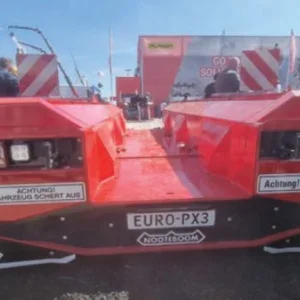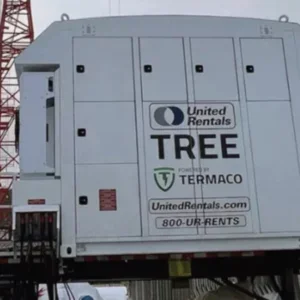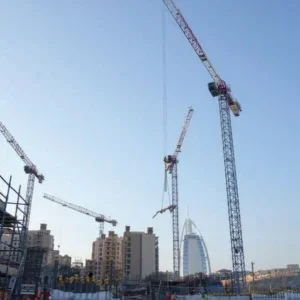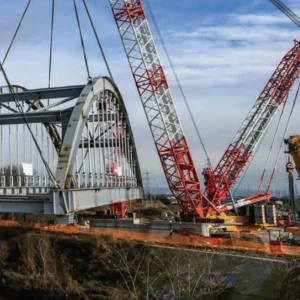Much has been said and written over the past 10 years or so about the demise of the truck crane in the face of the rising popularity of the German all terrains. All industry statistics show this to be true.
In 1979 world sales of truck cranes amounted to nearly 6,500 units. By the mid to late 1980s they were running at less than 2,000 and in the past three years at less than 1,000 units a year.
Evidence of decline can even be found in the product lines on offer. Five years ago Grove, for example, offered a range of 10 different truck crane models. Today it has just three, compared with nine GMK-branded all terrain models.
Despite this apparent decline, it is still an important market segment and in North America truck crane sales continue to outnumber sales of all terrain cranes, especially in capacity sizes below 80 US tons, where truck cranes dominate the road-going market in North America. In fact, the continent now accounts for at least half of world sales of truck cranes. In the Asia Pacific region truck cranes remain roughly twice as popular as all terrains, judging by new crane sales of recent years.
The truck crane segment has also seen some significant new product development this year. At the Conexpo show both Terex and Tadano showed new machines aimed specifically at the North American market.
Terex T 790 series
At ConExpo Terex introduced the T 790 series, rated at 90 US tons (81.6t) and the first in a new 700 series of hydraulic truck cranes. The T 790 has a five section dual mode full power boom that extends to 138ft (42.1m). Two swing-on jib options are available: either 32ft or 33ft-57ft. (9.68m or 10.15m-17.30m), with the latter taking maximum tip height to 202ft (61.6m). The boom has an externally mounted, primary extend cylinder which saves weight and makes inspection and maintenance easier, Terex says. This enables operation of the crane in one of two different modes. In mode ‘A’, boom sections two to five extend together as a group, for maximum lifting capacity. Once section two is fully extended, sections three to five then synchronously extend to full boom length.
In ‘B’ mode, section two remains retracted, while sections three to five proportionally extend. This faster set up is described by Terex as ‘enhancing the 790’s utility in real-world, on the job picks’.
Included are features to ensure that it is a single operator machine, such as hydraulically self-fitting counterweight a pin style quick reeving boom head and hook block. Two-speed main and auxiliary winches are standard and have 461ft/min (150m/min) maximum line speed and 18,450lb (8369kg) maximum line pull.
Unlike the 10ft wide T 750, now discontinued but with some units still available, the 790 has an 8ft 6in (2.59m) travel width, so no over-width permits are required in any of the 50 US states or Canadian provinces. It is also of non-permit length and height.
GVW is approximately 107,000lb (48.6t). With the counterweight stowed in its onboard rack and the boom riding on the available dolly, it comes in below 20,000lb (9.09t) per axle.
The 14 litre six cylinder Detroit Diesel Series 60 engine has fully integrated electronic controls and air-to-air aftercooling. The T 790 has air suspension and an Allison fully automatic transmission.
As with all Terex products, one of the most attractive features is the price, which is around $425,000 fully equipped. This is not just less than the $440,000 list price of the 75 US ton capacity T 750 with no extras (not even a jib extension), it is also significantly less than what a US purchaser might expect to pay for a 70 US ton German all terrain.
Tadano’s TT range
Also at Conexpo was the first of a new series of truck cranes from Tadano. This is the first time that the Japanese manufacturer has produced a truck crane for the North American market. Tadano, along with Kato, provided the backbone of many European fleets for years, though in recent years they have lost out to the all terrains. Their difficulties have been exacerbated by Nissan and Mitsubishi stopping production of crane carriers.
Development of the new truck crane range is the culmination of efforts by Tadano to broaden its offering to the North American market where historically it has concentrated on rough terrains. In recent years it has been marketing truck loaders and Faun all terrain cranes as well, the latter now also being distributed through Link-Belt distributors under a licensing agreement.
‘I have been saying for years that Tadano, with its good product reputation, should offer truck cranes,’ says Dan Mooney, operations manager of Long Island based Nu-Way Crane. ‘So I find it very good news that they are.’
Shown at Conexpo was the 80 US ton rated TT-800 XXL. Also becoming available is the 60 US ton TT-600 XL. The TT-800 XXL has the same upper as the new 80 ton RT and the TT-600 XL has the same upper as the 60 ton RT. The ‘XXL’ denotes a five section boom, while ‘XL’ denotes a four section boom. The TT-800 XXL, like Tadano’s 80 US ton rough terrain, has a 43.9m (144ft) boom and a 17.7m (58ft) bifold jib. The TT-600 XL, like the 60 ton RT, has a maximum boom length of 34m (112ft) and a 17.7m (58ft) jib.
Both these truck cranes have a four-axle carrier built by Tadano Faun in Germany. The front two axles steer, the rear two are driven. The six cylinder Cummins QSM11 engine produces 287kW (385hp) at 1800min-1. The transmission is a ZF 12 AS Tronic 2301 automatic with 12 forward and two reverse speeds.
Grove’s E series
Grove’s three truck crane offerings are the TMS 540E (40 US ton), TMS 700E (50 or 60 US ton) and the earlier generation TMS 875C (75 US ton). The 750E series is basically a 50 ton machine but is offered in 40 ton and 45 ton versions to help meet regional regulations. In Canada, for example, and certain states of the USA, cranes of 50 ton capacity and above are required to have an oiler as well as an operator. However, Grove says that it sells more 760s, the 60 ton model, than 750s.
Next step from Grove is likely to be a response to the competition with a new top end truck crane in the next 12 months. Grove has already started using the German-style Megaform profile boom on its rough terrain cranes and is now planning to use this type of boom shape on its next truck cranes. It will not be fitted to existing models, however, nor can we expect to see this boom style on cranes below 50 US ton capacity.
Link-Belt’s HTT
Link-Belt’s lattice boom truck cranes serve a niche with limited competition, while in the telescopic market it offers units of 40, 50, 60 and 70 US ton capacities.
Since last year all models have air suspension as standard, with the advantages of improved ride and handling. For pick and carry work the air bag springs are deflated so the carrier frame rests on the solid suspension. Inflation and deflation is controlled from a switch in the cab.
New from Link-Belt this year is the addition of rear steering on three of its telescopic truck cranes. The new series of machines, called Hydraulic Truck Terrain (HTT), comprises the HTT-8660 (60 US ton), HTT-8670 (70 US ton) and the HTT-8670 Long Boom (70 US ton), the latter of which was exhibited at Conexpo in Las Vegas in March.
With the rear axles now steerable, the operator has four modes of steering available; independent front, independent rear, all-wheel coordinated, and crab steer. Rear steering gives a turning radius of 29ft 6in (centreline to centreline).
‘It is the next logical step for us to add the rear steer feature to hydraulic truck cranes,’ says Roy Burger, Link-Belt’s telescopic crane product manager. ‘Manoeuvrability is critical to a crane’s productivity and by adding rear steer these cranes only get better.’
The Europeans
While the American and Japanese truck cranes have purpose-built crane carriers, European truck cranes – as produced by such companies as Sennebogen, Luna, Ormig, Marchetti and Cormach – have commercial, rather than purpose built, carriers and thus are perhaps more comparable to the American boom truck concept.
Some, such as those produced by Italian manufacturers Cormach and TCM, are designed as recovery cranes. Cormach has delivered five units of its M1601 (four-axle, 40t) to the Italian fire brigade commission. TCM has a range of five recovery crane models from 45t to 105t capacity, mounted on commercial chassis.
Other European truck cranes, such as Sennebogen’s 30t rated 630 TM and Ormig’s 80t 804AC, both of which were shown at Bauma 2001, are aimed specifically at those crane users who face highway restrictions when trying to move the heavier all terrain cranes. Ormig’s 804AC has a GVW of 32t and sits on a four axle truck. No special permits are required for either machine, thus offering a compact and manoeuvrable, yet simpler and lower cost, alternative to the all terrain.
There are many in the industry who regard all terrains as just an oppressive and expensive fashion. For most jobs,they will tell you, a simple trusty truck crane is more than enough.






